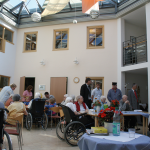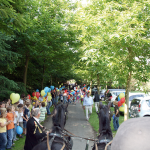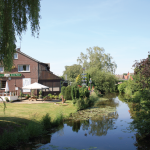Ramsdorf, North Rhine-Westphalia, Germany
Ramsdorf, municipality Velen, lies in West Münstreland and has at the moment a population of 6,000. Until 30 years ago the region lived form farming and the textile industry. When, at the beginning of the eighties the textile factory in Ramsdorf had to fire its 1,000 employees, the retail trade began to suffer because of the offers in the district town and the rate of commuters rose to 50 percent the village began to look for a future. At the end of the nineties in a cooperation of citizens and politicians an integrated development was initiated. The appeal of the flat country, the proximity to the Netherlands and the sustainability of the existing social structures in organized neighbourhood help and clubs were recognised as potentials and developed.
Firstly the municipality made an endeavour to stop the emigration and the economic downfall and strengthen trade by introducing a discount store in the village centre.
There is a distinct sense of street and house structure. The restyling of the village centre with castle and newly erected village hall are witness to the efforts to strengthen the village character which already in some places has clear small town characteristics. Clever advance planning and concept designs for existing building gaps or house that were empty or in need of renovation underline this dedication. In the past few years the municipality has reduced the maximum size of residential property in the large new building areas. The house in these housing estates are located so that the power of the sun (passive or with solar collectors and photovoltaic) can be optimally used.
These design measures are supported by a high identification of the people of Ramsdorf with their village. Not only the village hall and castle are points if identification but also the numerous clubs and “Hooks”. „Hook communities“ are old neighbourhood collectives whose original purpose was to help each other in times of death, christening, wedding or house building. A future crystallising point of this self confidence will probably be the partially voluntary conversion of the old dairy into a multifunctional village house that has room for all clubs.
But the solidarity and distinctive identification with the village is accompanied by a great openness: The village logo for example reflects the ambition to form the future in cooperation with the neighbouring village Velen with which it always rivalled. Ramsdorf is member and often the motor in numerous regional cooperations. The most striking of these is the foundation „agri-cultura“, in which twelve municipalities from the regions Achterhoek (Netherlands) and West Münstreland (Germany) have got together to mutually develop and advertise tourism in their regions. This open and constructive cooperation seems even more logical as Ramsdorf has, since the eighties, looked for its economic future in an up until now quite successful tourist marketing of the village that not only focuses one-sidedly on bike tourism but also on a rural cultural tourism.
The integration of all generations in the social life and the provision of contemporary social structures are of great importance in Ramsdorf. Kindergarten, public full-time schools and all day education and care opportunities for school children and a youth house run by the youths themselves create a family friendly atmosphere. A trend setting facility is also the old people’s home that sets exemplary priorities with its structure – with flats that look out on to a “market place” and its design – with an attractive garden of senses. The efforts will be rounded off with attended flats in the village centre that are still to be built.
The development in Ramsdorf is impressive in several ways. The social proximity and intact social network, the great willingness for personal contribution and the future targeted initiatives for strengthening the social cohesion stand out in particular. In addition great recognition should be given to the distinct sensibility for an intact village image adapted to the cultural heritage that is taken into account through high quality renovation and perceptive building.
Evaluated: 2008



